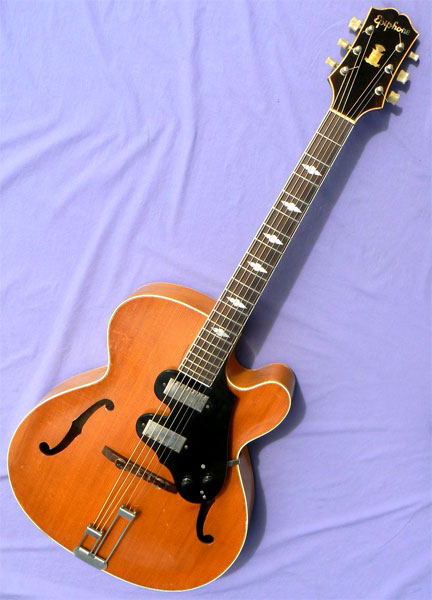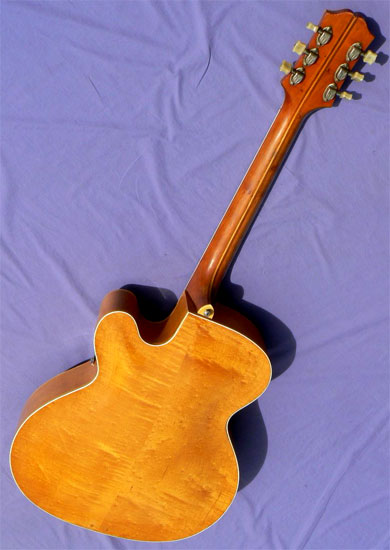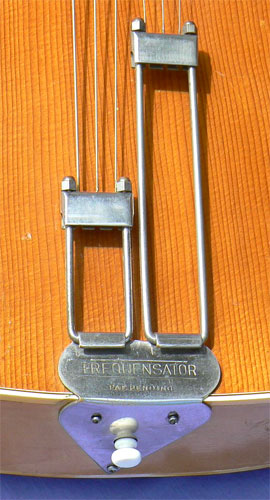 .
.Home / Instruments /Accessories / Ordering / Tips
archtop.com

1950 Epiphone Triumph Regent, Double Pickup Pickguard
Status: Pricing and hold status for all instruments currently available is shown on our Instruments page here. If this instrument does not appear on the Instruments page it has been sold, and is no longer available. Photos and descriptions of Previously Sold instruments may be found here. To be notified of examples of this model or similar instruments in the future, please contact [email protected],. Please be specific on which instrument(s) you're looking for, and we'll be happy to contact you as soon as they become available.
Serial #: 61032, New York label
Body size at lower bout: 17 3/8" Scale length: 25 1/2" Neck width at nut: 1 11/16"
Finish: Blonde finish, nitrocellulose lacquer type.
Materials: Handcarved, bookmatched solid spruce top; solid carved maple back; tiger flame maple sides; 5 piece cherry neck with walnut centerstripe; Brazilian rosewood fingerboard with diamond mother of pearl inlay; adjustable compensated Brazilian rosewood bridge, pearl peghead inlay, triple-bound top, bound fingerboard, back and headstock.
Hardware: 100% original hardware includes nickel 16X1 epsilon logo Epi tuners; original nickel Frequensator tailpiece; original hand bound tortise shell tortoise pickguard with epsilon logo; original adjustable compensated rosewood bridge; Epiphone C-2 Spectrum double pickup cutaway pickguard assembly, with cable.
Notes: In June of 1948, Gibson debuted a "Finger Rest Pickup" on an L-7 model at the NAMM music industry trade show. This unit, now known as the "McCarty" pickup after Gibson's chief engineer, incorporated one or two floating P-90 pickups into a custom pickguard designed to convert acoustic archtops for electric play. Around the same time, one of the Epiphone partners, Frixo, designed a double floating pickguard pickup system for his own '47 Emperor, using a pair of Epi "Tone Spectrum" single coil pickups. By November of 1950, the Epiphone conversion pickup was listed in the company's price list as the "Epiphone Spectrum Pickup in Pickguard Unit" and came in single and double versions, for cutaway or non-cutaway guitars. Like the McCarty, the Spectrum could be ordered as a factory option on a new guitar, or added as an aftermarket part. The McCarty pickup remained in Gibson's catalog until 1970, and was a popular option for their carved top guitars. The Spectrum pickup, by contrast, is now so rare that even the most diligent collectors have never even seen one, much less had the opportunity to play one of the fabled units.
Epiphone debuted the Triumph Regent in 1949. The cutaway version of Epis most popular professional archtop, the model was manufactured in New York for only about three years, and is accordingly a much scarcer item than its non-cutaway cousin, or its competitor, the Gibson L-7C. The Epiphone cutaway design was deeper than Gibson's, allowing greater access to the uppermost frets, and cutaway Epis generally tend to have greater acoustic projection than their Kalamazoo rivals as well.
This blonde beauty left the New York factory in 1951, and would appear to have had the pickup assembly added shortly thereafter. Made of polished black bakelite, this "C-2" model has master volume and tone controls, and a screw-on mini-jack of the type used on postwar DeArmond pickups. The twin single coil pickups have adjustable poles, like the DeArmond 1100 Rhythm Chief, and are remarkably similar in tone, with the clear airy responsiveness and a slight microphonic quality, prized in the DeArmonds, that capture some of the soundboard resonance in addition to the magnetic response of the strings alone. Completely self-contained and non-invasive, the entire Spectrum unit may be detached without a trace by removing just three small screws.
Unplugged, the guitar is a classic Epi; so acoustically powerful that one wonders how often the pickup was required in the first place. Triumph Regents are among the very few cutaway guitars that can compare favorably in volume with their noncutaway contemporaries. (It's only a pity Epiphone didn't make more of them. Production tapered off sharply after 1953, and dwindled to a mere handful by the firm's demise in 1956.) This fine example has all original hardware and finish, and has been carefully maintained without pick, buckle, thumb or fingerboard wear. Some normal checking in the deeply ambered natural finish, and a single hairline dryness crack, now soundly resealed in the upper bass bout, are the principal signs of age in this well loved instrument. The neck binding has been professionally replaced, and the back has been soundly reattached to the end block.
The solid carved back has attractive birdseye maple figure, contrasting handsomely with the solid cherry neck with walnut and maple centerstripe. Action is smooth and low over freshly dressed original fretwork, and the neck has a comfy medium C profile, quite contemporary in feel. Rare as they come, this guitar is no mere wall hanger, but rather a highly versatile and deeply expressive performer. You will be the first on your block to possess a blonde 1951 Epiphone Triumph Regent with genuine C-2 Spectrum pickguard pickup, but only if you call now.
Setup: The frets have been precision leveled, recrowned and polished; trussrod tension and neck relief adjusted; bridge height adjusted; bridge compensation set; string slots at nut and bridge inspected and recut as necessary; bridge foot contour inspected and fit to top as necessary; bridge radius inspected and recurved as necessary; bridge wheels and tuners lubricated; fingerboard and bridge oiled; body and neck cleaned and hand polished.
This instrument is strung with medium gauge nickel strings (.013-.056). The guitar will accommodate lighter or heavier gauge strings, according to preference. String action is set at 5/64" to 6/64" at the 12th fret, with moderate relief for acoustic playing with medium strings. The action may be lowered or raised to your requirements with the adjustable bridge.
Case: Original black Epiphone plush lined hardshell case .
.


